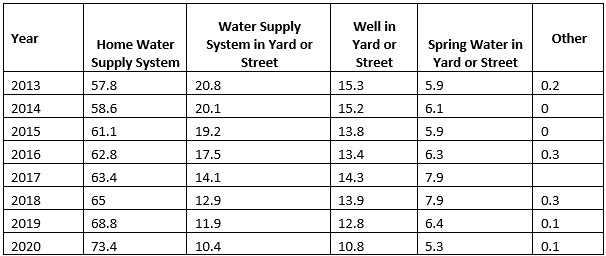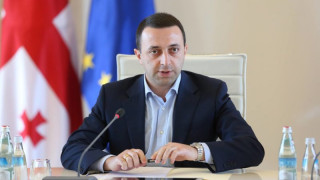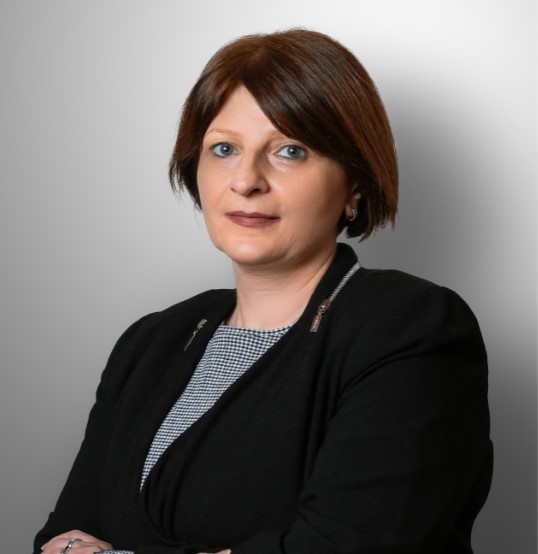Irakli Gharibashvili: “Water supply projects will be completed in every municipality within the course of three years and all of them will have a 24-hour water supply.”
Verdict: FactCheck concludes that the Prime Minister’s pledge cannot be kept.
Resume: According to the data of the National Statistics Office of Georgia, 69% of Georgia’s population had a water supply in 2020.
Only 58% of Georgia’s population had a home water supply system in 2013. Under the eight years of the Georgian Dream’s rule, this portion of population increased by 15 percentage points which is two percentage points of growth on average every year. The figure that Prime Minister announced to complete water supply projects – GEL 350 million (in three years – implies spending GEL 117 million every year). Each year, larger sums of money have been spent on the rehabilitation of the water supply infrastructure but, nevertheless, in eight years the Georgian Dream only accomplished 15.6 percentage points of growth of the population with a home water supply system. Therefore, FactCheck believes that it is impossible to provide water to 31% of the population with lesser funds and in a shorter timeframe.
Given these circumstances, FactCheck concludes that the Prime Minister’s pledge to ensure a 24-hour water supply to every municipality in three years cannot be kept.
Analysis
Prime Minister Irakli Gharibashvili spoke about projects which the authorities plan to carry out in the next three years at the session of the Government of Georgia and made pledges in specific fields.
As promised by the Prime Minister, every municipality will have a 24-hour water supply for 2025. As stated by Mr Gharibashvili: “Water supply projects are to be completed in every municipality within the course of three years and all of them will provide a 24-hour water supply. This project will be funded in the amount of GEL 350 million.” According to the regional statistical data of the National Statistics Office of Georgia, 73.4% of Georgia’s population had a home water supply system in 2020. The statistical figures of the last several years are as follows:
Table 1: Division of Households in Terms of Main Sources of Drinking Water (%)

Source: National Statistics Office of Georgia
According to the statistical data, this portion of the population increased by 15 percentage points under the eight years of the Georgian Dream’s rule which is two percentage points of growth on average every year.
Around 99.5% of Tbilisi residents have a home water supply system. In regard to Georgia’s regions, the respective figures for 2020 are as follows: Kakheti – 61.4%, Shida Kartli – 52.1%, Kvemo Kartli – 67.5%, Samtskhe-Javakheti – 77.9%, the Ajara Autonomous Republic – 77%, Guria – 42.4%, Samegrelo-Zemo Svaneti – 40.7%, Imereti – 61.2%, Mtskheta-Mtianeti – 71.1%, Racha-Lechkhumi and Kvemo Svaneti – 61.3%. Based on these figures, Tbilisi is followed by Samtskhe-Javakheti, the Ajara Autonomous Republic and Mtskheta-Mtianeti in terms of home water supply systems.
According to the results of a survey of water supply facilities conducted by the National Statistics Office of Georgia, 25 enterprises provided water supply in Georgia in 2020 and the total volume of water they supplied to domestic households reached 229.2 million cubic metres which is 2.6% more as compared to the same figure of the previous year. As of 31 December 2020, 2.57 million people (68.9%) were connected to a water supply system which is 2.1% more as compared to the same figure of the previous year.
Graph 1: Number of People Connected to a Water Supply System (%)

Source: National Statistics Office of Georgia
In accordance with the statistical data, nearly one-third of the Georgian population is not connected to a water supply system. Under the Georgian Dream’s rule, the amount of population with a water supply has been increasing by 2% on average every year. The Prime Minister made a pledge that in three years, 31% of the Georgian population currently without water will not only be connected to a water supply system but they will have a 24-hour water supply. Furthermore, the Prime Minister intends to achieve this with GEL 350 million.
Over the course of the past several years, vast sums of money have been appropriated for the rehabilitation of the water supply infrastructure (GEL 166 million in 2016, GEL 184 million in 2017, GEL 195 million in 2018, GEL 294 million in 2019, GEL 245 million in 2020 and GEL 330 million in 2021). The figure that the Prime Minister announced for allocation is GEL 350 million (in three years – implies spending GEL 117 million every year). Each year, larger sums of money have been spent on the rehabilitation of the water supply infrastructure but, nevertheless, in eight years the Georgian Dream only accomplished 15.6 percentage points of growth of the population with a home water supply system. Therefore, FactCheck believes that it is impossible to provide water to 31% of the population with lesser funds and in a much shorter timeframe.
Therefore, the Prime Minister’s pledge that every Georgian municipality will have 24-hour water supply in three years cannot be kept.








